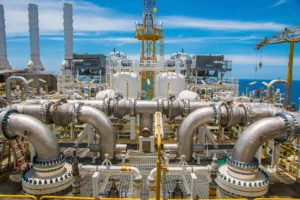Air motors can generate continuous rotating power when coupled with a compressed air supply. When compared to electric motors, they have many benefits. Operating costs for air motors are expected to be higher than those for electric motors due to the high price of compressed air. Variations in airflow and pressure can affect the speed and torque of air motors fed directly from a facility’s air system.
Air motors often utilize designs like pistons, turbines, and rotary vanes. Manufacturing settings commonly deploy air motors featuring radial pistons. The use of lubricated air allows for these designs to function at peak efficiency and extend service life. Air motors are tailored options for areas where oily air would be a problem. Turbine motors are the best option when high speeds are necessary, but low starting torque is acceptable.
Piston motors
Manufacturers opt for piston air motors when seeking low-speed precision, minimal frequency variation, and high power. These motors can comprise two to six cylinders, with their housings arranged axially or radially. Cylinder pressure on reciprocating pistons generates the output torque.
Motors with four or more pistons yield consistent torque at a steady working speed due to overlapping power pulses. Overlapping power strokes and careful balancing make for perfectly smooth operation in an engine at any speed.
Inlet pressure, piston count, cylinder area, stroke length, and piston speed impact piston motor power output. Boosting motor speed, piston diameter, piston count, or stroke length increases power output at a constant inlet pressure. Valve airflow regulation and piston mass are key factors restricting top speed.
As radial and axial-piston motors are self-lubricating, they require regular oil and grease checks and top-offs. Installing the bearings in a horizontal orientation ensures proper lubrication. A radial-piston motor with the shaft oriented vertically downward is not the norm, but at least one brand caters to this preference. Manufacturers and other mounting orientations require special lubrication arrangements.
Vane motors
Applications requiring low to medium power outputs are typical for rotary vane motors. Many mixing, driving, twisting, and pulling applications rely on simple and small vane motors, most commonly found powering portable power tools.
In a vane motor, each vane is eccentrically positioned concerning the motor’s body housing barrel, while the rotor features radial slots running along its length. Depending on the construction, springs, cam motion, or air pressure, push the vanes against the housing’s internal wall to create a seal. The rotor’s rotation generates centrifugal force that assists in the sealing action. Applying pressure to one side of the vanes results in torque.
Raise the air pressure entering a multi-vane motor to create a more significant pressure differential between the vanes, and the resulting torque will increase at the same speed. Conversely, increasing the inlet air pressure is linked to expenses and disadvantages, including hastened wear and reduced vane lifespan.
The number of vanes in a rotary vane air motor can range from three to ten. Increasing the number of vanes results in more consistent and stable torque output at lower speeds, and this effect persists when the vanes operate at higher speeds as well.. But more vanes mean more resistance, a higher motor cost, and less efficient operation.
Vane motors are more efficient than piston air motors due to their wide operating speed range (100–25,000 rpm at the rotor, based on housing diameter). For vane motors, lubricated air is often required due to vane gliding along the container wall. Especially during short duty cycles or prolonged motor inactivity. Motors that can run on unlubricated air are becoming increasingly common, both for practical reasons and because of environmental concerns.
Vane air motors without speed control should never be run at full speed with no load. Running a load-free multi-vane motor can lead to overheating and charging of vane tips against the cylinder wall. Other motor components may also experience abnormal wear and damage.
Turbine motors
The performance of an air motor can be calculated as its actual power production divided by the potential power available from the hydraulic pressure at the expansion ratio at which the equipment is working.
Turbines have an efficiency between 65% and 75% when converting pneumatic power into mechanical power. Due to the lack of internal friction caused by the contacting surfaces of parts, turbines are more efficient than other air motors. In this way, excessive lubrication is unnecessary. The elimination of lubricating oil vastly enhances cold-weather functionality.
Until recently, turbine air motors found predominant usage in applications requiring rapid velocity and minimal starting torque, like dentistry drilling and jet aircraft starters. Contemporary turbine technology is now applied to reciprocating engines of various sizes. Modern turbine technology allows for low-maintenance, lubricant-free, and contaminant-tolerant pneumatic starters. Turbine starters include planetary gear reductions to lower the turbine’s high rotor speed to more manageable engine cranking speeds.
When compared to their power output, turbine motors are small and lightweight. From 9:1 up to 20:1, higher gear ratios offer increased stall torque and compatibility with a wide range of power plants. Changing the horsepower of a turbine is as simple as adjusting the air pressure inside the machine.
A turbine air motor operates by propelling air through a nozzle and regulating its flow to a turbine wheel, also referred to as a rotor. It reverses air flow from high pressure and low speed to low pressure and high speed. The turbine’s power is proportional to the mass flow rate of air going through it. Power output is proportional to the square of the number of nozzles that pass through the nozzles.
Adapting the same fundamental starter design allows for the creation of a diverse array of models, covering various input pressures, cranking rates, and turning or stall torques. With this capability and a selection of gearboxes, manufacturers can mass-produce inexpensive starters for various uses.
Learn more about the different air motor technologies by clicking here.
For further insights and detailed technical information, consult the Pocket Guide to Air Motors by Atlas Copco or Contact us directly.


